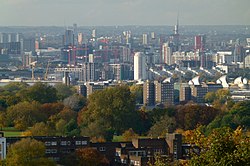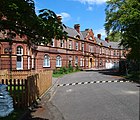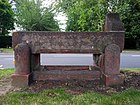
Woolwich is a town in southeast London, England, within the Royal Borough of Greenwich.
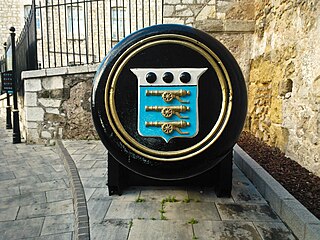
The Board of Ordnance was a British government body. Established in the Tudor period, it had its headquarters in the Tower of London. Its primary responsibilities were 'to act as custodian of the lands, depots and forts required for the defence of the realm and its overseas possessions, and as the supplier of munitions and equipment to both the Army and the Navy'. The Board also maintained and directed the Artillery and Engineer corps, which it founded in the 18th century. By the 19th century, the Board of Ordnance was second in size only to HM Treasury among government departments. The Board lasted until 1855, at which point it was disbanded.
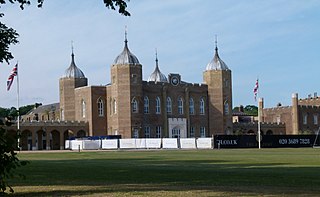
The Royal Military Academy (RMA) at Woolwich, in south-east London, was a British Army military academy for the training of commissioned officers of the Royal Artillery and Royal Engineers. It later also trained officers of the Royal Corps of Signals and other technical corps. RMA Woolwich was commonly known as "The Shop" because its first building was a converted workshop of the Woolwich Arsenal.

The Royal Arsenal, Woolwich is an establishment on the south bank of the River Thames in Woolwich in south-east London, England, that was used for the manufacture of armaments and ammunition, proofing, and explosives research for the British armed forces. It was originally known as the Woolwich Warren, having begun on land previously used as a domestic warren in the grounds of a mid-16th century Tudor house, Tower Place. Much of the initial history of the site is linked with that of the Office of Ordnance, which purchased the Warren in the late 17th century in order to expand an earlier base at Gun Wharf in Woolwich Dockyard.

Barracks are buildings used to accommodate military personnel. The English word originates from the 17th century via French and Italian from an old Spanish word "barraca", but today barracks are usually permanent buildings. The word may apply to separate housing blocks or to complete complexes, and the plural form often refers to a single structure and may be singular in construction.

Woolwich Garrison is a garrison or station of the British Army. Geographically it is in Woolwich, in the Royal Borough of Greenwich. In terms of command, it is within the Army's London District.

The Royal Army Veterinary Corps (RAVC), known as the Army Veterinary Corps (AVC) until it gained the royal prefix on 27 November 1918, is an administrative and operational branch of the British Army responsible for the provision, training and care of animals. They are also responsible for explosives and drug search dogs. It is a small corps, forming part of the Army Medical Services.

Cavalry Barracks is a former British Army installation located north of Hounslow Heath in Hounslow, west London. Hounslow was one of 40 new barracks established around the country in the wake of the French Revolution, to guard against the dual threats of foreign invasion and domestic sedition. The barracks later became a busy depot for the London military district. The barracks have been described by Historic England as 'one of the most significant and complete barracks in the country'; as of June 2021 the site is scheduled to be developed as a sustainable living project by Hounslow Council.

The Royal School of Artillery (RSA) is the principal training establishment for artillery warfare in the British Army. Established in 1915, it is located at Larkhill, Wiltshire, on the south edge of Salisbury Plain in the United Kingdom. The School is the primary training facility for Royal Artillery recruits, and is also home to the Gunnery Training Team.

The Royal Army Ordnance Corps (RAOC) was a corps of the British Army. At its renaming as a Royal Corps in 1918 it was both a supply and repair corps. In the supply area it had responsibility for weapons, armoured vehicles and other military equipment, ammunition and clothing and certain minor functions such as laundry, mobile baths and photography. The RAOC was also responsible for a major element of the repair of Army equipment. In 1942 the latter function was transferred to the Royal Electrical and Mechanical Engineers (REME) and the vehicle storage and spares responsibilities of the Royal Army Service Corps were in turn passed over to the RAOC. The RAOC retained repair responsibilities for ammunition, clothing and certain ranges of general stores. In 1964 the McLeod Reorganisation of Army Logistics resulted in the RAOC absorbing petroleum, rations and accommodation stores functions from the Royal Army Service Corps as well as the Army Fire Service, barrack services, sponsorship of NAAFI (EFI) and the management of staff clerks from the same Corps. On 5 April 1993, the RAOC was one of the corps that amalgamated to form The Royal Logistic Corps (RLC).
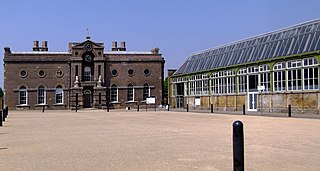
Greenwich Heritage Centre was a museum and local history resource centre in Woolwich, south-east London, England. It was established in 2003 by the London Borough of Greenwich and was run from 2014 by the Royal Greenwich Heritage Trust until the centre's closure in July 2018. The museum was based in a historic building in Artillery Square, in the Royal Arsenal complex, which was established in the 17th century as a repository and manufactory of heavy guns, ammunition and other military ware.
The Army Remount Service was the body responsible for the purchase and training of horses and mules as remounts for the British Army between 1887 and 1942.
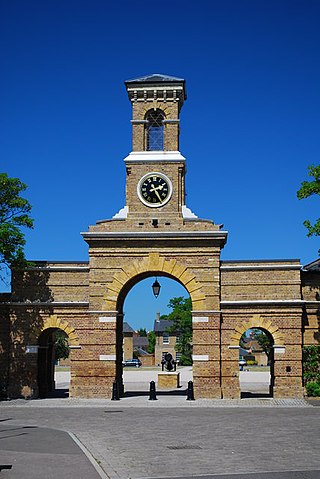
MoD Shoeburyness is a military installation at Pig's Bay near Shoeburyness in Essex.

The Royal Marine Depot, Deal was a military installation occupied by the Royal Marines and located in South Deal, Kent, on the road to Walmer. The Depot was first established in Deal in 1861, occupying part of the Royal Naval Hospital. In 1868 the Depot expanded and took over the nearby 18th-century Army barracks.

St Peter's Church is a Catholic church in Woolwich, South East London. It is situated between Woolwich New Road and Brookhill Road, the main entrance being on Woolwich New Road. The church was designed by Augustus Pugin in 1841–42 in the style of the Gothic Revival and is one of only three Pugin churches in London. Pugin's design remained unfinished as the projected tower and spire were never built. The parish of St Peter the Apostle serves the Catholic community of central Woolwich and surrounding areas, and is part of the Archdiocese of Southwark which is in the Province of Southwark.

St George's Garrison Church is a ruined church in Woolwich in the Royal Borough of Greenwich, South East London. It was built in 1862-63 as a Church of England place of worship for the Woolwich Royal Artillery garrison. The church was hit by a V-1 flying bomb in 1944 and largely destroyed by fire. The restored ruin with its canopied roof, its blue, red and yellow brick walls, its mosaics and a memorial garden is open to the public on Sundays.

The Shrapnel Barracks was a British army base providing living accommodation in Woolwich in southeast London from the mid-19th century until the 1960s. Named after Lieutenant General Henry Shrapnel, it was situated to the northwest of the modern-day Stadium Road, on the western edge of Woolwich Common; the site is now occupied by the Queen Elizabeth Hospital.

Royal Artillery Barracks, Woolwich, is a barracks of the British Army which forms part of Woolwich Garrison. The Royal Regiment of Artillery had its headquarters here from 1776 until 2007, when it was moved to Larkhill Garrison.

Woolwich Works, also known as Woolwich Creative District, is a multi-disciplinary cultural venue on the south bank of the River Thames in Woolwich in southeast London, that opened in September 2021.
Repository Woods is a 7 acres (2.8 ha) deciduous woodland area to the west of the British Army's Woolwich Garrison in the Royal Borough of Greenwich in southeast London. Initially created for pleasure use in the early 19th century, it was later used for military training, and is designated at Grade II as the UK's earliest known purpose-built military training landscape. Its features include training and practice earthworks, a stream and man-made lake and terraces; a Rotunda, designed by John Nash in 1814, is nearby.
